Scotland
17-18 September 1989
One of my earliest inspirations to become a field biologist was a 1983 TV nature documentary entitled "On the Tracks of the Wild Otter," by filmmaker Hugh Miles. He did his work in Shetland, and after I, myself, started tracking wild otters, I resolved that, if I ever returned to the UK, I would go to Shetland like Hugh Miles. By his and most other accounts, that seemed to be the best place in all the British Isles to find Lutra lutra.
So when I started planning my 1989 trip to the otter colloquium, Shetland was at the top of my original itinerary. I intended to spend a whole week there, which I felt was the minimum amount of time to get a feel for the place and do some serious otter spotting.
Unfortunately, after I started finding out how expensive overseas travel had become, I had to trim my original six-week itinerary down to only four, and eventually, I realized that I had to cut Shetland out of my plans altogether. Although disappointed, I was consoled that I was still going to spend 8 days in the Western Highlands, and there were lots of otters there, too, especially on the Isle of Skye, which was my principal destination.
Skye was also immediately adjacent to the place where Gavin Maxwell had lived with his otters and written his books in the Sixties, and he being an even bigger influence on me than Hugh Miles, I very much wanted to make a pilgrimage to Maxwell's "Camusfeàrna" on my upcoming birthday. So, off to the West I would go!

My long, sad train trip from Skipton to Glasgow came to an end at 9PM on the 17th; too late to do any sightseeing, which was perfectly alright, because there is little if anything TO see in Scotland's grim, gray, most-populous city.
I stayed overnight at the Blythswood Hotel, which was just a stone's throw from Glasgow Central Station. In its heyday, the Blythswood was doubtless a grand place, but a century of wear-and-tear had taken its toll, and it was now relegated to the status of a budget hotel. But, that was all I needed for one night, and actually, except for an oddly-buckled, sloping floor in my room, the Blythswood was more than satisfactory.
Breakfast in the hotel's old high-ceiling Victorian dining room was a treat, with yummy greasy eggs, bacon and sausages and all-you-can-eat toast. (I'm serious, I love that stuff!) Then I went to a nearby store to buy some wellingtons and a raincoat, checked out of the hotel, rented a car, and hit the road just before 10.
I'd driven a little in England during our 1974 visit, but this was the first time I would be taking an actual road trip driving entirely on the "wrong" side of the street. I don't know why that idea seems to intimidate a lot of Americans, but I had no trouble at all reorienting my driving habits. Within a minute or two, it felt like I'd been motoring like that my whole life.
It had been my intention to drive north out of Glasgow following the same route Mother and I took on our first day in Scotland in 1967, but I soon discovered that the highway - though still numbered the A82 - had been entirely redone and was unrecognizable, at least the portion of it that was in the city. Once in the vicinity of Loch Lomond, however, the country road looked much like it always had, though I noted that some much-needed bypasses had been constructed on the stretch of it leading up to Fort William.
It was there that I had a quick lunch and bathroom break, then headed west on the A830 toward my initial destination of Arisaig. Mother and I had stayed at a wonderful Bed & Breakfast there in 1974, and I hoped to be able to reprise my visit with Mrs. Pringle and her husband. Honestly, though, I had no idea where I'd be staying on any night for the next week. In terms of accommodations, I was totally "winging it" here in Scotland.
It's always surprising to me how good my memory is for roads I haven't traveled in ages, and the A830 was no exception. I seemed to know what lay ahead around every curve, and the vistas looked almost as familiar to me as if I had actually grown up there.
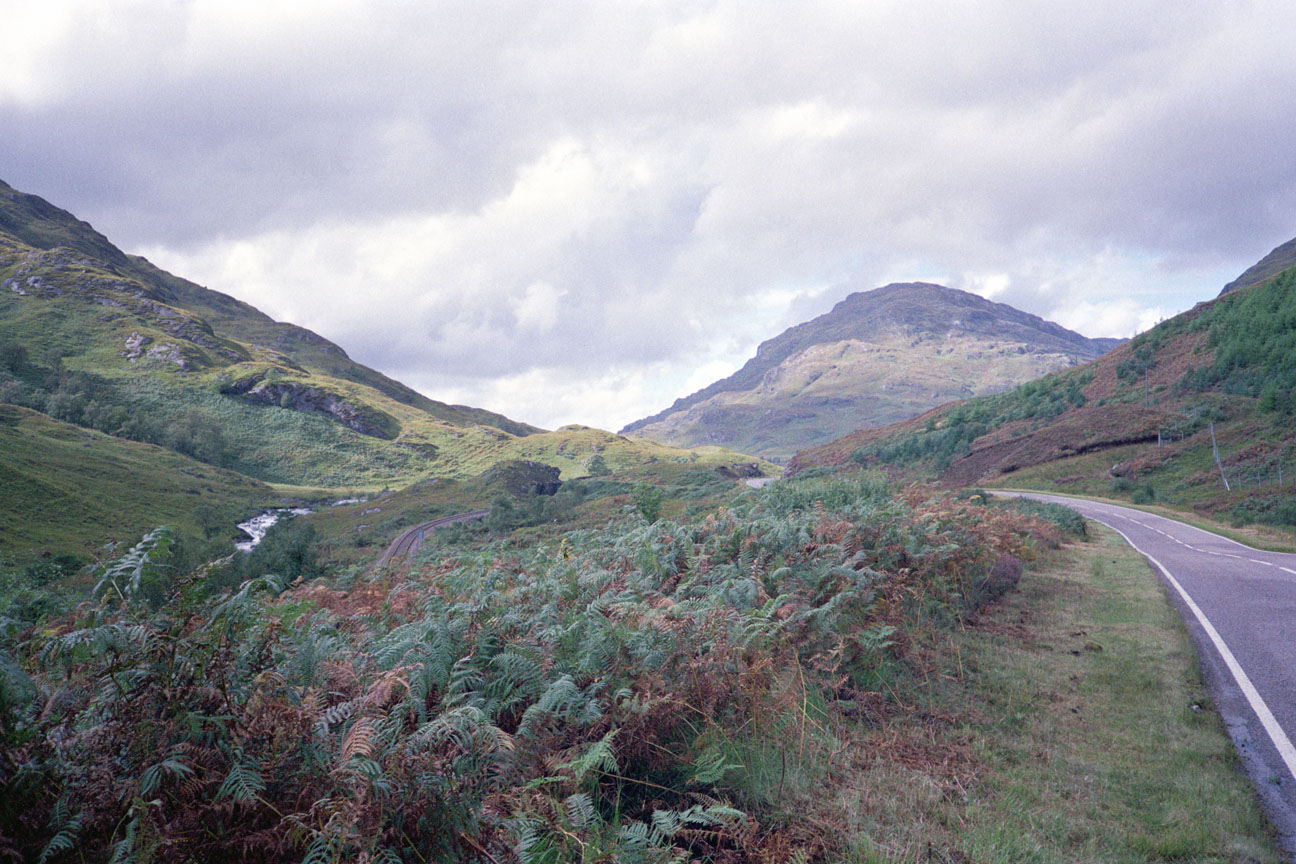
Half-way to Arisaig, looking west on the A830, about a mile west of Glenfinnan. The view today is obscured by dense overgrowth at left and a matured forestry plantation on the right.
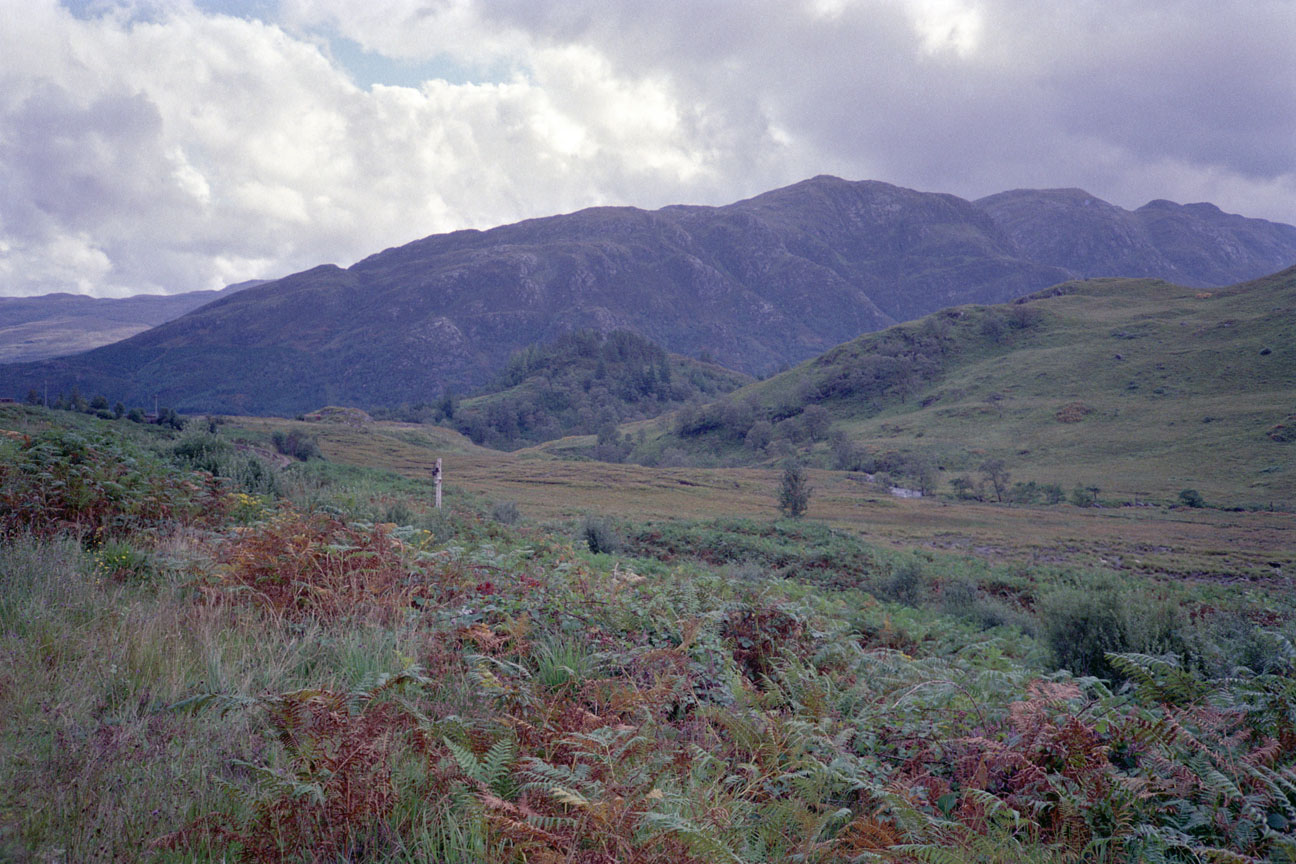
From the same vantage point, now turning to the left and facing southeast. Photos by J Scott Shannon.
In particular, the portion of the road from Lochailort into Arisaig had changed hardly at all. So amazing. Everything looked exactly as it had 15 years previous. It really felt like I was returning home.
Upon arriving at Arisaig, I was disappointed to see that Mrs. Pringle's was no longer a B&B. The house next door was, but the sign said no vacancy, which surprised me. I thought being a Monday afternoon, I wouldn't have any trouble at all finding a place to stay.
Oh, well. It was still too early to really start worrying about where I'd be spending the night. Perhaps I'd find a place up the road in Mallaig, where I planned to take the ferry over to Skye the next day. And actually, I did find a place there, but I decided I wanted to try and do some otter-spotting before nightfall. Chris Mason at the colloquium had told me that nearby Eilean Shona was a likely place to find otters, so I headed south with hopes held high.
A couple of miles past Loch Moidart, I passed a small hotel that had a vacancy, so I thought it might be a good idea to get a room there now rather than chance waiting until evening.
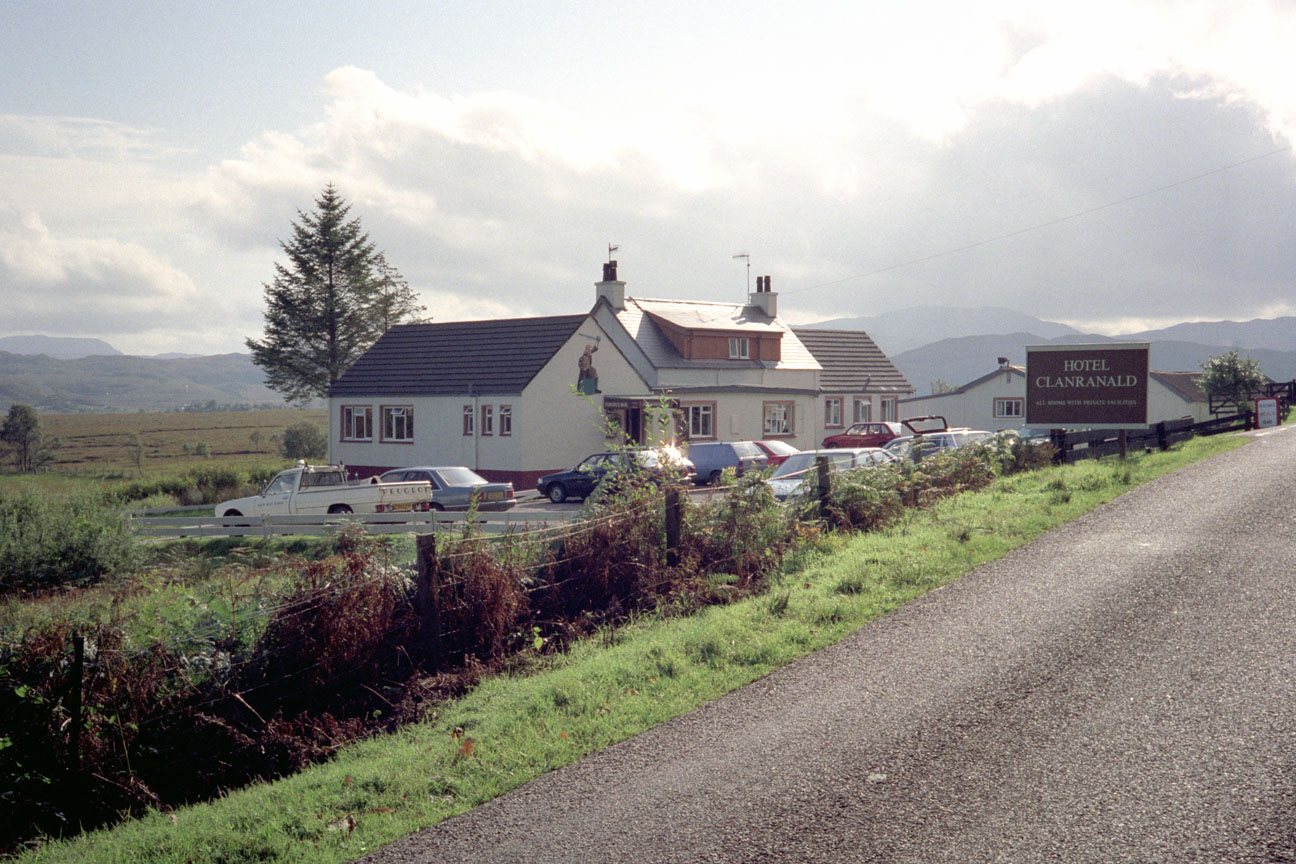
The Clanranald Hotel in Mingarry. The view today. Photo by J Scott Shannon.
Upon checking in, I told the proprietress, Fergie MacDonald, that I was in the area to try to find otters, and she told me that she had seen some before at an old pier on Loch Moidart that I had passed by on my way here. With that recommendation, I headed back in the direction that I came, but the skies opened up at that point, and with the car windows all steamed up, it seemed to me that I'd be better off heading to Eilean Shona, after all. Strike Two was finding the footpath gate there locked. Drat my luck. So I headed back yet again to the ruined pier Fergie had told me about, and with the rain now over, I was prepared to wait there until nightfall.
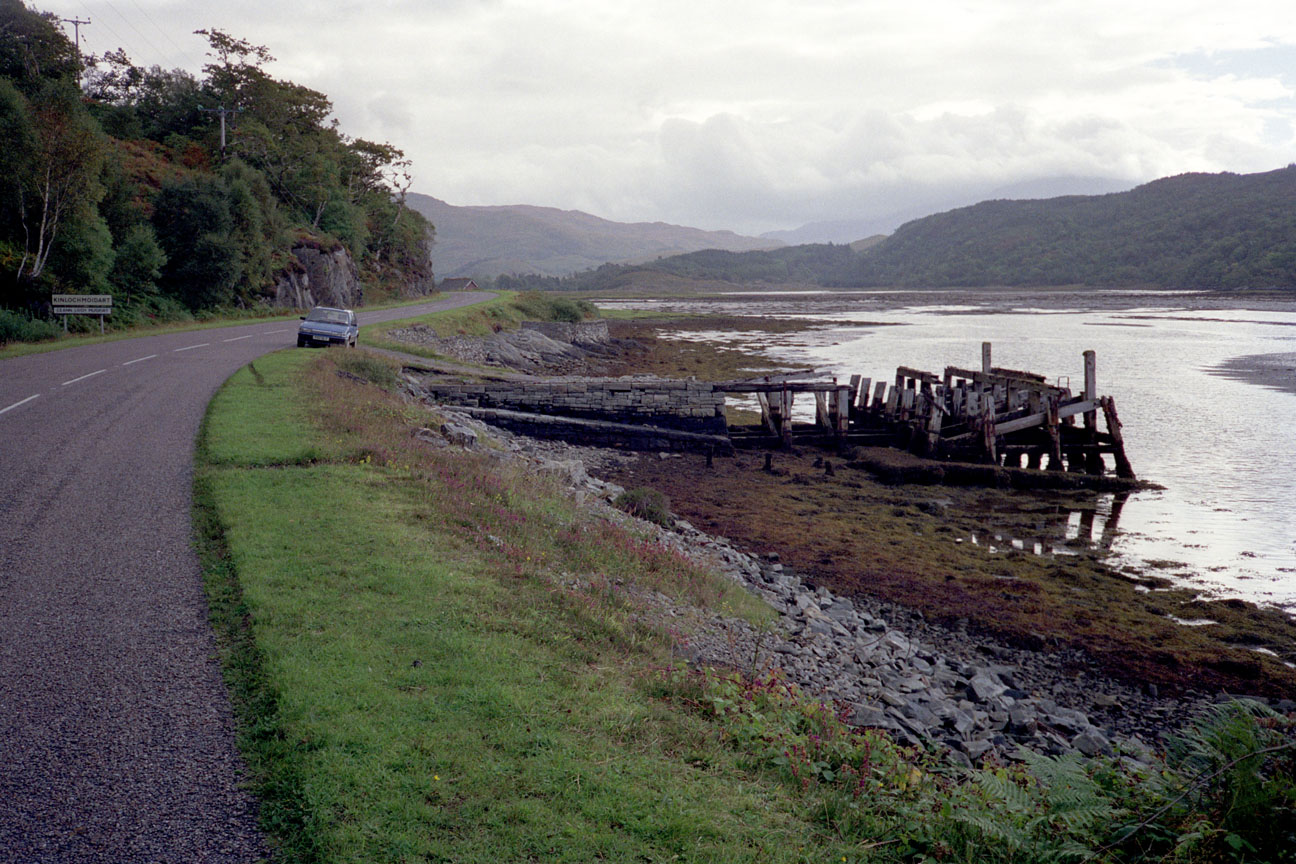
Looking east on the A861 at the ruined pier on the north shoreline of Loch Moidart. The view today is remarkably unchanged. Except for the removal of some crossbeams (probably to prevent climbing and injuries), the old pier has withstood its twice-daily tidal onslaughts relatively intact over the past three decades. Photo by J Scott Shannon.
Although the rain had stopped, I decided to stay in the car to do my otter-spotting, owing to my discovery of one of the area's least appealing features: the Highland midge. My god they were an annoyance. Five seconds outside and they were all over you, biting, thirsty for your blood. In the days to come, I noticed that almost every store and petrol station sold little bottles of DEET insect repellent next to the cash register. No doubt they were top sellers!
I was to make another discovery that otterless evening: the powerful tides in the Sound of Sleat. As I sat waiting at the ruined pier, I was amazed to be able to actually watch the tide rise in Loch Moidart, inch by inch almost by the second. It was just like a bathtub filling, only faster! I'd seen films of the tide coming in like this in the Bay of Fundy in Nova Scotia, but had never seen such a rapid rise in person. Later, I was glad I saw this on my first day, as I believe it kept me from making what could have been some serious mistakes of judgment in choices of lookouts from which to base my observations.
As just alluded to, though, I did not see any otters that evening. Both the tide and general poor visibility had been against me. I returned to Hotel Clanranald, happy to see that Fergie had kept my supper waiting for my late return. After serving me, she left me alone to finish while she retired for the night, and I did likewise soon after.
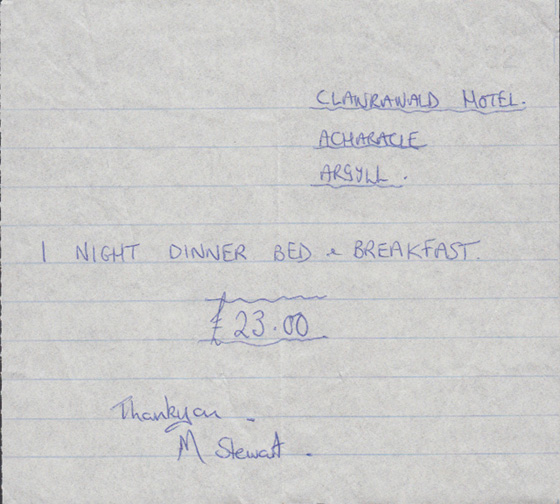
One of my earliest inspirations to become a field biologist was a 1983 TV nature documentary entitled "On the Tracks of the Wild Otter," by filmmaker Hugh Miles. He did his work in Shetland, and after I, myself, started tracking wild otters, I resolved that, if I ever returned to the UK, I would go to Shetland like Hugh Miles. By his and most other accounts, that seemed to be the best place in all the British Isles to find Lutra lutra.
So when I started planning my 1989 trip to the otter colloquium, Shetland was at the top of my original itinerary. I intended to spend a whole week there, which I felt was the minimum amount of time to get a feel for the place and do some serious otter spotting.
Unfortunately, after I started finding out how expensive overseas travel had become, I had to trim my original six-week itinerary down to only four, and eventually, I realized that I had to cut Shetland out of my plans altogether. Although disappointed, I was consoled that I was still going to spend 8 days in the Western Highlands, and there were lots of otters there, too, especially on the Isle of Skye, which was my principal destination.
Skye was also immediately adjacent to the place where Gavin Maxwell had lived with his otters and written his books in the Sixties, and he being an even bigger influence on me than Hugh Miles, I very much wanted to make a pilgrimage to Maxwell's "Camusfeàrna" on my upcoming birthday. So, off to the West I would go!

My long, sad train trip from Skipton to Glasgow came to an end at 9PM on the 17th; too late to do any sightseeing, which was perfectly alright, because there is little if anything TO see in Scotland's grim, gray, most-populous city.
I stayed overnight at the Blythswood Hotel, which was just a stone's throw from Glasgow Central Station. In its heyday, the Blythswood was doubtless a grand place, but a century of wear-and-tear had taken its toll, and it was now relegated to the status of a budget hotel. But, that was all I needed for one night, and actually, except for an oddly-buckled, sloping floor in my room, the Blythswood was more than satisfactory.
Breakfast in the hotel's old high-ceiling Victorian dining room was a treat, with yummy greasy eggs, bacon and sausages and all-you-can-eat toast. (I'm serious, I love that stuff!) Then I went to a nearby store to buy some wellingtons and a raincoat, checked out of the hotel, rented a car, and hit the road just before 10.
I'd driven a little in England during our 1974 visit, but this was the first time I would be taking an actual road trip driving entirely on the "wrong" side of the street. I don't know why that idea seems to intimidate a lot of Americans, but I had no trouble at all reorienting my driving habits. Within a minute or two, it felt like I'd been motoring like that my whole life.
It had been my intention to drive north out of Glasgow following the same route Mother and I took on our first day in Scotland in 1967, but I soon discovered that the highway - though still numbered the A82 - had been entirely redone and was unrecognizable, at least the portion of it that was in the city. Once in the vicinity of Loch Lomond, however, the country road looked much like it always had, though I noted that some much-needed bypasses had been constructed on the stretch of it leading up to Fort William.
It was there that I had a quick lunch and bathroom break, then headed west on the A830 toward my initial destination of Arisaig. Mother and I had stayed at a wonderful Bed & Breakfast there in 1974, and I hoped to be able to reprise my visit with Mrs. Pringle and her husband. Honestly, though, I had no idea where I'd be staying on any night for the next week. In terms of accommodations, I was totally "winging it" here in Scotland.
It's always surprising to me how good my memory is for roads I haven't traveled in ages, and the A830 was no exception. I seemed to know what lay ahead around every curve, and the vistas looked almost as familiar to me as if I had actually grown up there.

Half-way to Arisaig, looking west on the A830, about a mile west of Glenfinnan. The view today is obscured by dense overgrowth at left and a matured forestry plantation on the right.

From the same vantage point, now turning to the left and facing southeast. Photos by J Scott Shannon.
In particular, the portion of the road from Lochailort into Arisaig had changed hardly at all. So amazing. Everything looked exactly as it had 15 years previous. It really felt like I was returning home.
Upon arriving at Arisaig, I was disappointed to see that Mrs. Pringle's was no longer a B&B. The house next door was, but the sign said no vacancy, which surprised me. I thought being a Monday afternoon, I wouldn't have any trouble at all finding a place to stay.
Oh, well. It was still too early to really start worrying about where I'd be spending the night. Perhaps I'd find a place up the road in Mallaig, where I planned to take the ferry over to Skye the next day. And actually, I did find a place there, but I decided I wanted to try and do some otter-spotting before nightfall. Chris Mason at the colloquium had told me that nearby Eilean Shona was a likely place to find otters, so I headed south with hopes held high.
A couple of miles past Loch Moidart, I passed a small hotel that had a vacancy, so I thought it might be a good idea to get a room there now rather than chance waiting until evening.

The Clanranald Hotel in Mingarry. The view today. Photo by J Scott Shannon.
Upon checking in, I told the proprietress, Fergie MacDonald, that I was in the area to try to find otters, and she told me that she had seen some before at an old pier on Loch Moidart that I had passed by on my way here. With that recommendation, I headed back in the direction that I came, but the skies opened up at that point, and with the car windows all steamed up, it seemed to me that I'd be better off heading to Eilean Shona, after all. Strike Two was finding the footpath gate there locked. Drat my luck. So I headed back yet again to the ruined pier Fergie had told me about, and with the rain now over, I was prepared to wait there until nightfall.

Looking east on the A861 at the ruined pier on the north shoreline of Loch Moidart. The view today is remarkably unchanged. Except for the removal of some crossbeams (probably to prevent climbing and injuries), the old pier has withstood its twice-daily tidal onslaughts relatively intact over the past three decades. Photo by J Scott Shannon.
Although the rain had stopped, I decided to stay in the car to do my otter-spotting, owing to my discovery of one of the area's least appealing features: the Highland midge. My god they were an annoyance. Five seconds outside and they were all over you, biting, thirsty for your blood. In the days to come, I noticed that almost every store and petrol station sold little bottles of DEET insect repellent next to the cash register. No doubt they were top sellers!
I was to make another discovery that otterless evening: the powerful tides in the Sound of Sleat. As I sat waiting at the ruined pier, I was amazed to be able to actually watch the tide rise in Loch Moidart, inch by inch almost by the second. It was just like a bathtub filling, only faster! I'd seen films of the tide coming in like this in the Bay of Fundy in Nova Scotia, but had never seen such a rapid rise in person. Later, I was glad I saw this on my first day, as I believe it kept me from making what could have been some serious mistakes of judgment in choices of lookouts from which to base my observations.
As just alluded to, though, I did not see any otters that evening. Both the tide and general poor visibility had been against me. I returned to Hotel Clanranald, happy to see that Fergie had kept my supper waiting for my late return. After serving me, she left me alone to finish while she retired for the night, and I did likewise soon after.
